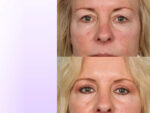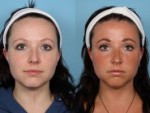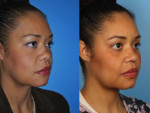Dermabrasion, Lasers, and Chemical Peels (TCA Peels)
In the last half of this century, men and women have had more leisure time to spend outdoors than in previous generations. Many hours spent on outside recreations and the prevalence of both summer and winter vacations, have all taken their toll on people’s skin. Premature wrinkling is more common now than ever before. Both men and women seek facial plastic surgery to reverse the effects of sun damaged skin. Surgery may also improve the pitted look of acne scars and remove pre-cancerous skin growths called keratoses.
If you’ve wondered how skin resurfacing with chemical peeling or dermabrasion could improve the look of your skin, your self-confidence, or your health, you need to know how chemical peeling and dermabrasion are performed and what you can expect from these procedures. No pamphlet can answer all of your concerns, so a consultation with a Facial Plastic Surgeon is important.
Successful facial plastic surgery is a result of good rapport between patient and surgeon. Trust, based on realistic expectations and exacting medical expertise, develops in the consulting stages before surgery. Your surgeon can answer specific questions about your specific skin problems.
Is Skin Resurfacing For You?
The most basic requirement for any surgery is good health. Other requirements are more subtle and should be carefully considered in discussions with your surgeon. Expectations of surgery and of the facial plastic surgeon must be realistic. Skin resurfacing procedures cannot produce perfect skin; rather the goal is to improve the appearance of the skin as much as possible.
Skin type and color, ethnic background, and age are important factors that should be discussed prior to surgery. If you have dark skin or problems such as allergies, previous burns, a history of poor scars, or radiation exposure, you may need special evaluation to determine if you are a candidate for these procedures. If you have had episodes of cold sores and blisters around the mouth, inform your surgeon of this condition.
Before deciding on a skin resurfacing procedure, your facial plastic surgeon may recommend a skin care regimen prior to the procedure. If you have extensive damage from aging or injury, more than one procedure may be necessary.
Making The Decision For Skin Resurfacing
Whether you seek a chemical peel or dermabrasion for functional or cosmetic reasons, your choice of a qualified facial plastic surgeon is of paramount importance. The surgeon will examine your skin to assess factors that could affect the outcome of the surgery and to determine the proper procedure for your condition. You and your surgeon will explore your attitudes toward surgery, and discuss realistic expectations and risks. Trust is built through these discussions, and the agreement between surgeon and patient is a prerequisite for a successful outcome to the surgery.
Understanding The Surgery
The skin is composed of the epidermis and the dermis. Within the dermis are two layers, both of which are constructed of collagen, long fibers that loosen and stretch with age and sun damage. If the deepest layer, the reticular layer, is damaged, scars result, while the upper layer of the dermis, the papillary layer, heals from injuries without scarring. In a chemical peel, the surgeon applies one of several chemicals to the skin. Glycolic acid is the mildest. TCA, trichloroacetic acid, can be used in varying strengths for longer-lasting smoothness. The deepest peel is done with phenol. Dr. Sidle will help you choose which peel is best suited to your individual goals and skin type.
Dermabrasion is a surgical technique whereby some deeper scars and wrinkles can be smoothed. This is NOT the same procedure as the much less productive microdermabrasion. In medical dermabrasion, the surgeon uses a local anesthetic and/or a freezing agent to render the skin numb. Then, using a high speed rotating brush, the surgeon removes the top layer of skin to the appropriate level for the best results. The size and depth of scars and the degree of wrinkling determine the length of the surgery as well as the length of recovery. Let Dr. Sidle at Northwestern Facial Plastic Surgery help you form an individualized treatment plan.
Laser surgery is used to resurface facial skin with wrinkles caused by excess sun exposure, “crow’s feet,” and acne scarring. The high energy, amplified light waves of carbon dioxide (CO2) laser vaporize the top layer of skin instantly, with no bleeding and minimal trauma to the surrounding skin. Newer Fractional (or Fractionated) CO2 lasers can offer dramatic results with less downtime and a quicker recovery. Laser resurfacing of the skin is often best performed in conjunction with other procedures such as blepharoplasty and facelift surgery. Again, let Dr. Sidle at Northwestern Facial Plastic Surgery help you form an individualized treatment plan.
What To Expect After The Surgery?
Immediately following a chemical peel, laser peel, or dermabrasion, the surgeon may apply a dressing to your skin. Swelling and “crusting” of the skin are normal, and ointments to keep the skin supple will be applied for seven to 10 days following surgery. The redness of skin that persists after the initial healing phase will usually fade in about 4 weeks. The surgeon often recommends a soft diet, avoidance of extremes in temperature and any activity that would cause stress to healing skin.
In one to two weeks after surgery, new skin will emerge that is pink, finer, and free of many wrinkles. It can take several weeks for all the redness to vanish. Often this redness can easily be covered up with cosmetics. Follow-up care involves using sunblock in order to protect the skin while new pigment is created. Patients may notice that the skin remains lighter for some time after surgery, but that condition will usually subside when the skin’s pigment level has been restored.
Facial plastic surgery makes it possible to correct many facial flaws and signs of premature aging that can undermine self-confidence. By changing how you look, cosmetic surgery can help change how you feel about yourself.
Why Prefer Dr. Silde For Skin Resurfacing?
Experience Matters. As a double board-certified Facial Plastic Surgeon at Northwestern with expertise in the face and neck, Dr. Sidle can provide you with an individualized plan to achieve your goals of less facial lines and more youthful skin. Call our office for a one-on-one consultation.
More Skin Resurfacing FAQs
Skin resurfacing is an effective procedure that removes the outer layers of skin to reduce the depth and size of the lines on the skin.
Yes, Laser skin resurfacing is worth it. This type of skin resurfacing uses lasers to treat wrinkles, scars, acne, and other skin problems. The laser light gently removes the top layer of your skin without causing any pain.
If you’ve had laser skin resurfacing, it generally takes 3 – 4 months to recover completely, but it varies based on your healing process.
Skin resurfacing can be a worthwhile cosmetic surgery. Depending on the procedure, it can improve your skin’s appearance; the results may last more than a few years.
You must undergo six laser resurfacing treatments to remove your skin’s old cells and re-creating new healthy skin tissue.
After resurfacing, patients are usually advised to avoid direct sunlight, but you can also take the following steps:
- Drinking plenty of water and orange juice
- Wearing sunscreen every day
- Taking your time to heal. You can also take aloe vera and vitamin E.
A TCA peel can last anywhere from several months to several years, depending on the depth of the peel and the individual’s skin type. Deeper peels will last longer than superficial peels. People with oily skin or prone to acne may find that their TCA peel lasts for a shorter period than those with drier skin. Additionally, sun exposure can reduce the lifespan of a TCA peel.
Avoid sun exposure, smoking, and excessive drinking before skin resurfacing. These can damage the skin, decrease the effectiveness of the treatment and increase the risk of complications.
Chemical peel varies in price depending on the type of peel and the doctor’s office. However, most chemical peels average between $100 and $300 per session. Some may be more expensive or less expensive, but this is a general estimate.
After a chemical peel, the face may look red, swollen, and irritated. The skin may also peel off in sheets over the next few days. New and regenerated skin will gradually appear. Most people are happy with their results after a chemical peel. However, it is important to realize that not everyone’s skin reacts the same way to a chemical peel, and some people may not see any difference in their appearance after a peel.
Yes, insurance may cover chemical peels depending on the specific procedure and the reason for the peel. Generally, insurance will cover procedures that are considered to be medically necessary. A consultation with a board-certified dermatologist can help to determine if a chemical peel is the best treatment option for your needs and whether or not it is covered by insurance.
Most chemical peels require between 3-6 sessions for optimal results. However, this may vary depending on the type of peel used and the severity of damage to the skin.
Post-Operative Instructions
All post-operative instructions can be found on the Patient Resources page.
Our Results
Click Here to access our Before and After gallery of procedures.





